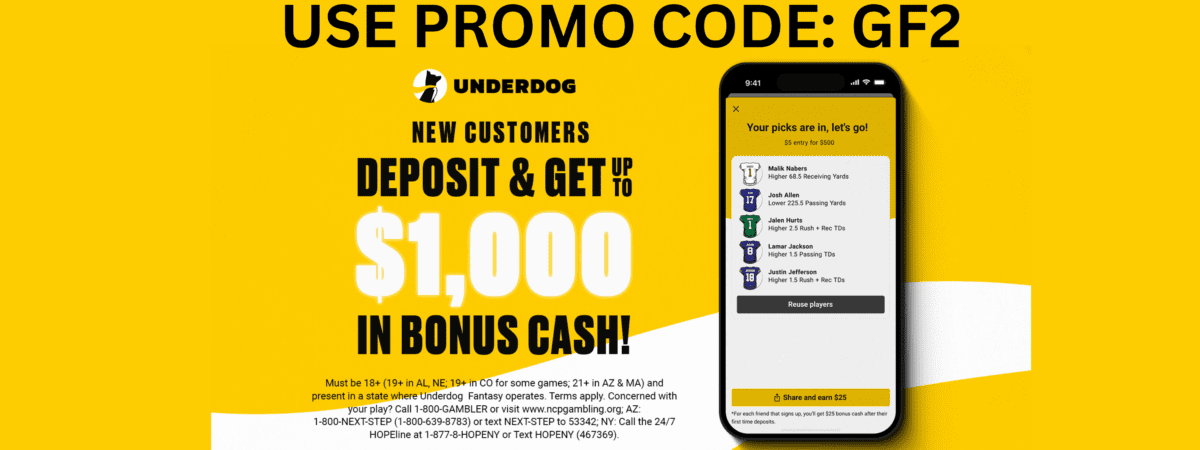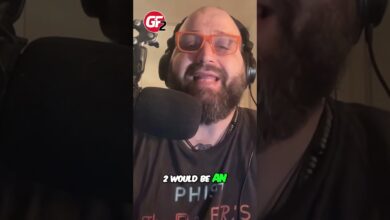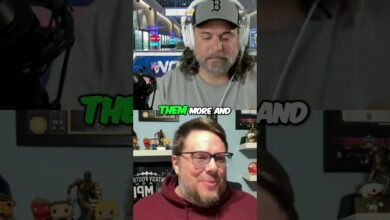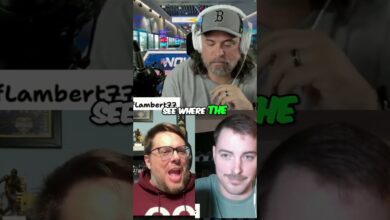Dynasty Strategy: Sell Out to Win Now or Build for the Future?
Cooper Adams of Fantasy Points recently wrote a very interesting article on how to value assets in dynasty leagues. The article discussed the two elements of a player’s dynasty value, which are intrinsic and extrinsic value. Intrinsic value measures the fantasy points a player can provide immediately. Extrinsic value is a measure of future potential, with age being a key factor.
This can be further broken down into quadrants. Players with both high intrinsic and extrinsic value are superstars like Patrick Mahomes. Productive vets are older players with high intrinsic but low extrinsic value. Alternatively, players with low intrinsic but high extrinsic value are often young with high draft capital. Finally, players with both low intrinsic and extrinsic values are best left on your bench. The example given was JuJu Smith-Schuster, which hurt as his dynasty manager.
What I’d like to do today is expand this logic to your entire team and your opponents’ teams. Most dynasty analysis assumes you already know whether you’re going all-in or rebuilding. However, this is a very important decision that should be made within the context of your competition. It’s a league-specific decision.
Take a look at the graph below. It takes in the dynasty values of each roster and plots team value from Keep Trade Cut on the x-axis and median roster age on the y-axis. That value metric includes both intrinsic and extrinsic value. To attempt to split the two, we also look at a roster’s age. By doing this, we split teams into four quadrants, just like we did for players.
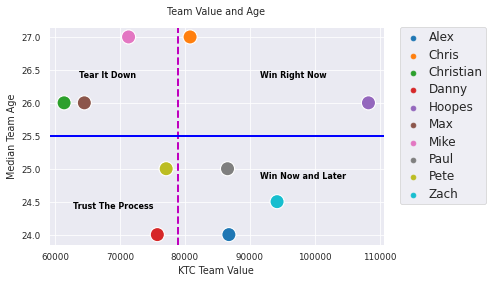
Teams with both high intrinsic and extrinsic value fall in the bottom-right; they’re primed to win both now and into the future. Older teams with most of their value being intrinsic are in the top-right quadrant; they need to win now before rebuilding. Alternatively, rebuilding teams with low intrinsic but high extrinsic value are in the bottom-left; as a Sixers fan, we call that trusting the process. Finally, teams with both low intrinsic and extrinsic values should consider turning their attention to that rebuild.
As an example, the purple dot on the graph’s far right is my team. I won the championship last year (flags fly forever) and my team has the largest dynasty value according to Keep Trade Cut. However, it’s an aging roster, with most of its value firmly in the intrinsic bucket. Think CMC, Cooper Kupp, and Travis Kelce. There is a clear directive to win now before my team falls off the age cliff.
A more difficult decision is Chris, who is the orange dot in the top-middle of the graph. He made it to the championship last year. If you were to look at his roster without the context of his opponents, I think you’d tell him to push his chips in. However, he has one of the oldest rosters in the league and the 5th highest Keep Trade Cut dynasty value. Should he start his rebuild now or give it one last try?
Expanding the intrinsic/extrinsic framework to your entire team and opponents’ teams allows you to tailor your strategy to the realities of your specific league. Another benefit is it also allows you to target trade partners based on your unique strengths/weaknesses and their unique strengths/weaknesses. Take a look at the graphs below.
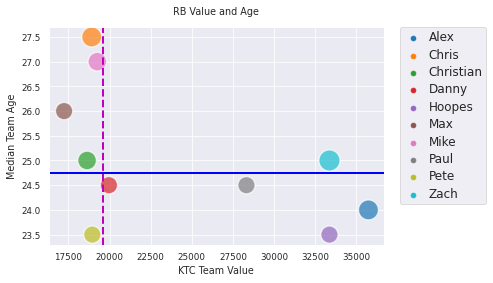
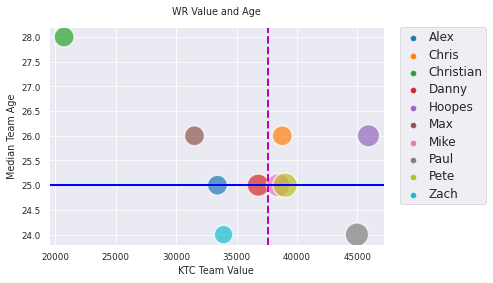
It’s the same idea as the whole team graph, but now we’ve split the graphs by position. Zach is the light blue dot on each graph, while Paul is the grey dot. The size of the bubble represents how many players of that position each manager currently has. Zach has a relatively large amount of valuable running backs and a small number of wide receivers. Paul has the opposite roster construction. It’s a quick way to determine potential trade partners, keeping in mind the context of your opponent’s general strategy according to their team-level position.
Here is a link to the code that produces these graphs so you can create them for your own league. You don’t have to have any prior coding knowledge to produce these. All you need is a Google account and a few minutes to fill in your league’s rosters. After you click the link, hit the “Open in Colab” button near the top of the screen and follow the instructions at the top. If you run into any problems, feel free to reach out to me on Twitter @TargetShares. Hopefully this helps you decide whether you’re all-in, trusting the process, or something in between.
ATTN Dynasty Commissioners: Do you want to do something cool for your league? How about a 1-hour live show dedicated to YOUR league? Team-by-team breakdowns, rankings, and more. For details and to book a show, visit: GoingFor2.com/plp.
